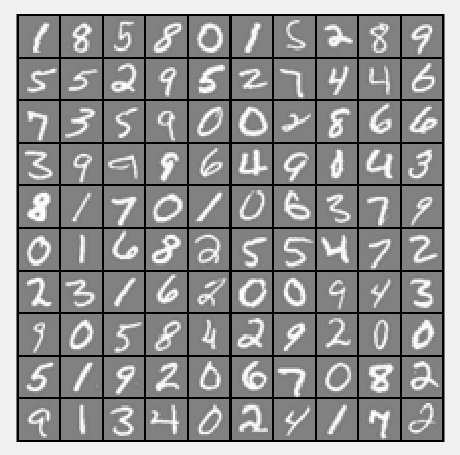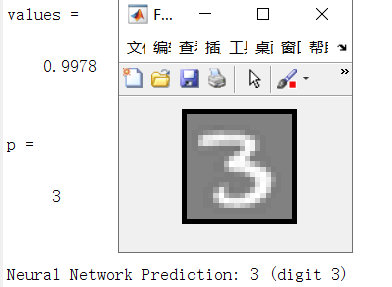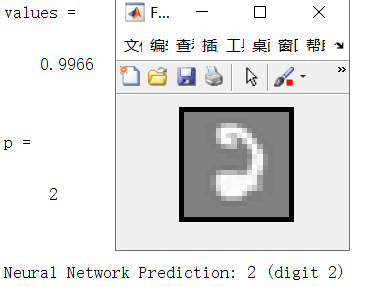机器学习作业(三)多类别分类与神经网络——Matlab实现
2024-09-06 06:50:56
题目太长了!下载地址【传送门】
第1题
简述:识别图片上的数字。
第1步:读取数据文件:
%% Setup the parameters you will use for this part of the exercise
input_layer_size = 400; % 20x20 Input Images of Digits
num_labels = 10; % 10 labels, from 1 to 10
% (note that we have mapped "0" to label 10) % Load Training Data
fprintf('Loading and Visualizing Data ...\n') load('ex3data1.mat'); % training data stored in arrays X, y
m = size(X, 1); % Randomly select 100 data points to display
rand_indices = randperm(m);
sel = X(rand_indices(1:100), :); displayData(sel);
第2步:实现displayData函数:
function [h, display_array] = displayData(X, example_width) % Set example_width automatically if not passed in
if ~exist('example_width', 'var') || isempty(example_width)
example_width = round(sqrt(size(X, 2)));
end % Gray Image
colormap(gray); % Compute rows, cols
[m n] = size(X);
example_height = (n / example_width); % Compute number of items to display
display_rows = floor(sqrt(m));
display_cols = ceil(m / display_rows); % Between images padding
pad = 1; % Setup blank display
display_array = - ones(pad + display_rows * (example_height + pad), ...
pad + display_cols * (example_width + pad)); % Copy each example into a patch on the display array
curr_ex = 1;
for j = 1:display_rows
for i = 1:display_cols
if curr_ex > m,
break;
end
% Copy the patch % Get the max value of the patch
max_val = max(abs(X(curr_ex, :)));
display_array(pad + (j - 1) * (example_height + pad) + (1:example_height), ...
pad + (i - 1) * (example_width + pad) + (1:example_width)) = ...
reshape(X(curr_ex, :), example_height, example_width) / max_val;
curr_ex = curr_ex + 1;
end
if curr_ex > m,
break;
end
end % Display Image
h = imagesc(display_array, [-1 1]); % Do not show axis
axis image off drawnow; end
运行结果:

第3步:计算θ:
lambda = 0.1;
[all_theta] = oneVsAll(X, y, num_labels, lambda);
其中oneVsAll函数:
function [all_theta] = oneVsAll(X, y, num_labels, lambda) % Some useful variables
m = size(X, 1);
n = size(X, 2); % You need to return the following variables correctly
all_theta = zeros(num_labels, n + 1); % Add ones to the X data matrix
X = [ones(m, 1) X]; for c = 1:num_labels,
initial_theta = zeros(n+1, 1);
options = optimset('GradObj', 'on', 'MaxIter', 50);
[theta] = ...
fmincg(@(t)(lrCostFunction(t, X, (y==c), lambda)), initial_theta, options);
all_theta(c,:) = theta;
end; end
第4步:实现lrCostFunction函数:
function [J, grad] = lrCostFunction(theta, X, y, lambda) % Initialize some useful values
m = length(y); % number of training examples % You need to return the following variables correctly
J = 0;
grad = zeros(size(theta)); theta2 = theta(2:end,1);
h = sigmoid(X*theta);
J = 1/m*(-y'*log(h)-(1-y')*log(1-h)) + lambda/(2*m)*sum(theta2.^2);
theta(1,1) = 0;
grad = 1/m*(X'*(h-y)) + lambda/m*theta; grad = grad(:); end
第5步:实现sigmoid函数:
function g = sigmoid(z)
g = 1.0 ./ (1.0 + exp(-z));
end
第6步:计算预测的准确性:
pred = predictOneVsAll(all_theta, X);
fprintf('\nTraining Set Accuracy: %f\n', mean(double(pred == y)) * 100);
其中predictOneVsAll函数:
function p = predictOneVsAll(all_theta, X) m = size(X, 1);
num_labels = size(all_theta, 1); % You need to return the following variables correctly
p = zeros(size(X, 1), 1); % Add ones to the X data matrix
X = [ones(m, 1) X]; g = zeros(size(X, 1), num_labels);
for c = 1: num_labels,
theta = all_theta(c, :);
g(:, c) = sigmoid(X*theta');
end [value, p] = max(g, [], 2); end
运行结果:

第2题
简介:使用神经网络实现数字识别(Θ已提供)
第1步:读取文档数据:
%% Setup the parameters you will use for this exercise
input_layer_size = 400; % 20x20 Input Images of Digits
hidden_layer_size = 25; % 25 hidden units
num_labels = 10; % 10 labels, from 1 to 10
% (note that we have mapped "0" to label 10) % Load Training Data
fprintf('Loading and Visualizing Data ...\n') load('ex3data1.mat');
m = size(X, 1); % Randomly select 100 data points to display
sel = randperm(size(X, 1));
sel = sel(1:100); displayData(X(sel, :)); % Load the weights into variables Theta1 and Theta2
load('ex3weights.mat');
第2步:实现神经网络:
pred = predict(Theta1, Theta2, X);
fprintf('\nTraining Set Accuracy: %f\n', mean(double(pred == y)) * 100);
其中predict函数:
function p = predict(Theta1, Theta2, X) % Useful values
m = size(X, 1);
num_labels = size(Theta2, 1); % You need to return the following variables correctly
p = zeros(size(X, 1), 1); X = [ones(m,1) X];
z2 = X*Theta1';
a2 = sigmoid(z2);
a2 = [ones(size(a2, 1), 1) a2];
z3 = a2*Theta2';
a3 = sigmoid(z3)
[values, p] = max(a3, [], 2) end
运行结果:

第3步:实现单个数字识别:
rp = randperm(m); for i = 1:m
% Display
fprintf('\nDisplaying Example Image\n');
displayData(X(rp(i), :)); pred = predict(Theta1, Theta2, X(rp(i),:));
fprintf('\nNeural Network Prediction: %d (digit %d)\n', pred, mod(pred, 10)); % Pause with quit option
s = input('Paused - press enter to continue, q to exit:','s');
if s == 'q'
break
end
end
运行结果:



最新文章
- 用Okhttp框架登录之后的Cookie设置到webView中(转)
- EntityFramework code first 一些常用的约束特性
- ycsb-命令及参数-与生成的负载类型相关
- python主要用来做什么
- 使用UltraEdit+BCC5.5搭建C语言学习环境(转)
- 数据库操作类util
- Linux管线命令
- iOS学习之基本概念
- E297: Write error in swap file解决方法
- SEO 优化,网站推广优化教程100条(SEO,网站关键字优化,怎么优化网站,如何优化网站关键字)
- Fitnesse测试用例脚本自动生成设计
- CentOS安装配置MySql数据库
- C++ 异常小记
- 如何卸载Centos自带jdk
- python+django+uwsgi 搭建环境
- Linq 中的 in 与 not in 的使用
- C# SQLite数据库操作
- google-protobuf安装详解
- 为什么不能用Abort退出线程
- linux一切皆文件之文件描述符(一)